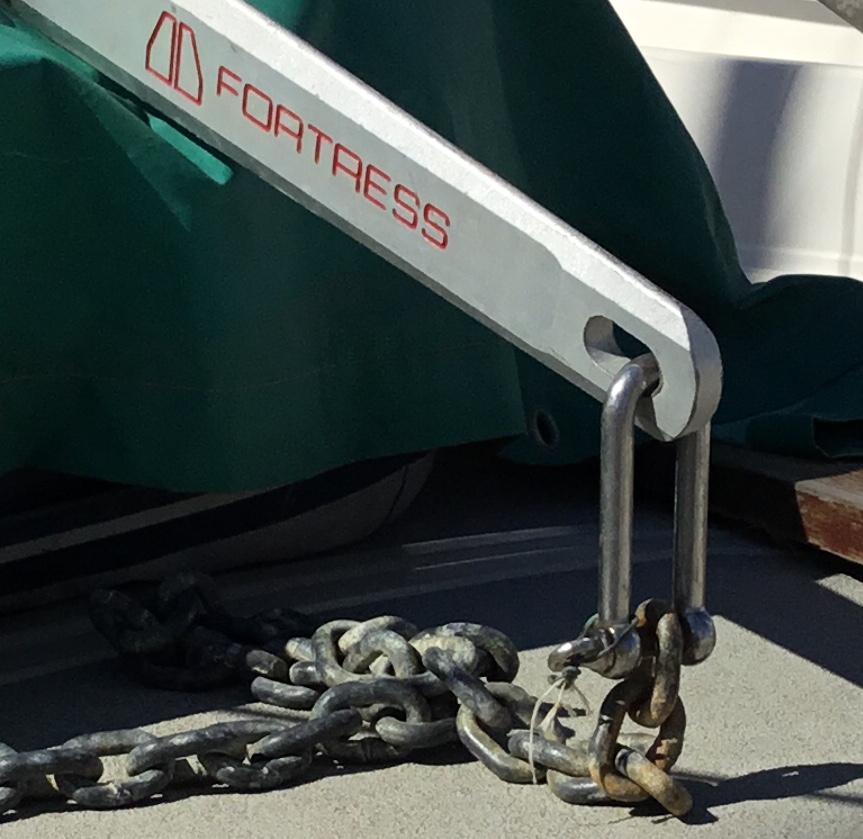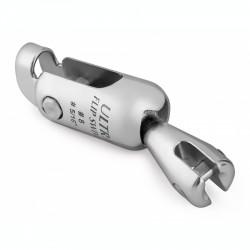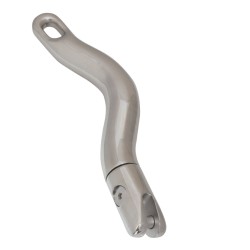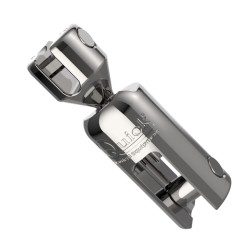Jimmy Green anchor-to-chain connectors provide a strong snag-free profile joint between your anchor chain and your anchor, including swivel, flip and articulated options.
Combining stainless steel with galvanised steel is common practice, but we advise that the chain and fittings be inspected and replaced regularly - cutting the last link off your chain seasonally is a good idea.
If you are unsure whether or not your chosen fittings will fit together, please feel free to call or email with a request to check compatibility.
Look around any marina, harbour or anchorage, and you will find various methods employed to join a yacht’s anchor to the anchor rode.
There is no right or wrong way to attach the two, but there are some general principles to follow which should lead to a successful conclusion.
Applying the following principles to the decision-making process should lead to the optimum set-up of any individual anchoring system.
How to choose the correct anchor to chain connectors or shackles for my yacht or boat and fit them together in good order?
Galvanised or Stainless Steel Anchor Connectors?
Generally speaking, avoiding contact between dissimilar metals is better because of the eventual corrosive reaction. However, the widespread use of stainless steel connections on galvanised anchor systems indicates that the deterioration is either very slow or manageable.
Therefore, with the proper precautions, a combination of the two metals is acceptable where required - read more on Dissimilar Metals
The decision for stainless steel anchors and chains is fairly straightforward - use stainless steel fittings to join the two together. There is a wide range of different makes and models to suit all budgets.
For galvanised anchors and chains, a galvanised connection is a natural choice. However, the options available are realistically limited to shackles only - Purchase Anchoring Shackles
Galvanised Dee and Bow shape shackles generally feature a protruding head with a hole drilled through it for a. Tightening and b. Securing the pin. It is worth noting that any protrusion may cause snagging or jamming through the stem head roller. Flush-fitting pins are mostly found on stainless steel shackles.
Correct Alignment of Load Bearing Surfaces
Spread the load by matching the length and shape of the two bearing surfaces as closely as possible, e.g. a round pin in a snug round hole with both parts the same length. Avoid pinpoint loads.
Providing Articulation
There is always the possibility of an ‘awkward’ wrenching pull being exerted on the anchor shank and/or the connection to the anchor chain when the anchor is retrieved, i.e. not a straight pull. Therefore, the anchor connection must be capable of coping with applied force from any direction.
Allowing or Encouraging Rotation
An anchor will only successfully dock into the stem head fitting if facing up the right way. An anchor swivel connector will allow the anchor to rotate as it approaches the bow roller. In addition, some connectors are designed to actively twist or flip the anchor into the correct plane for re-entry.
Strength and Quality
Components that are rated with a manufacturer-minimum break load will provide reassurance. The integrity of any anchor system can be compromised by one weak link. The working life of each part will depend on the quality of the base metal and the finish. Steel should be a minimum grade 40 and treated with hot dip galvanising. N.B. Electroplating will only last for a short while in a marine environment. Stainless steel should be a minimum grade 3 marine quality A316.
Good Practice
Alignment
Couple shackles together ‘back to back,’ i.e. with the two crowns bearing against one another.
Fit the largest diameter pin possible through the end link of the chain for the strongest possible joint.
Fit the largest, shortest pin possible through any ‘square cut’ hole, e.g. the slot in some anchor shanks.
Use the more open, rounded shape of bow shackles to allow more freedom of movement where required.
Use D shackles to achieve a narrower fitting, especially those with a flush head to the pin.
Take advantage of the oversized bow shackles factory-fitted to some anchor brands, e.g. CQR. These shackles often feature a flush pin head with the thread permanently welded.

Unilateral Movement
Fit a connector which provides for flip, twist, swivel and articulation - all in one design, if possible, e.g. Ultra Flip Swivel
The Dee shackle in this example appears superfluous - this type of connector provides for rotation and lateral loading but is not readily available with a manufacturer-guaranteed breaking strain.

This shackle is not correctly aligned on the anchor slot but is oversized to compensate and facilitates unilateral movement in the correct location.
The Osculati Twist Connector has a long banana-shaped body to flip the anchor into the right position for docking on the stem head and incorporates a swivel for rotation.

Introduce three links of anchor chain between a standard swivel, e.g. a Kong design and the anchor.
Align back-to-back shackles correctly.
Use a Maillon Rapide (Chain Repair Link)

Pros: a good quality chain repair link should be as strong as the comparable size chain - this is a streamlined attachment with no snagging and a sympathetic bearing surface for chain links or pins at both ends.
Cons: the thread may require a little filing to fit through the end link in a calibrated chain - a thread-locking compound is required because seizing is impossible. In this instance, it does not allow lateral movement on the anchor connector.
Bad Practice
Alignment
Joining shackles together ‘pin to pin’ results in the bearing edges sliding from side to side.

Fitting the crown of a shackle through a ‘square cut’ hole so that the shackle bears on two unsympathetic stress points.


Freedom of Movement
Fitting an anchor connector directly to the anchor shank with no freedom of lateral movement is a prevalent practice. Although it looks neat, there is a strong possibility that, at some point, it will result in some damage or even failure when the anchor is trapped on the seabed.


Main Menu
Main Menu
Back
Main Menu
Back
Main Menu
Back
Back
Main Menu
Back
Main Menu
Back
Back
Main Menu
Back
Main Menu
Main Menu
Back
Main Menu
Back
Back
Back
Back
Back
Back
Back
Back







































